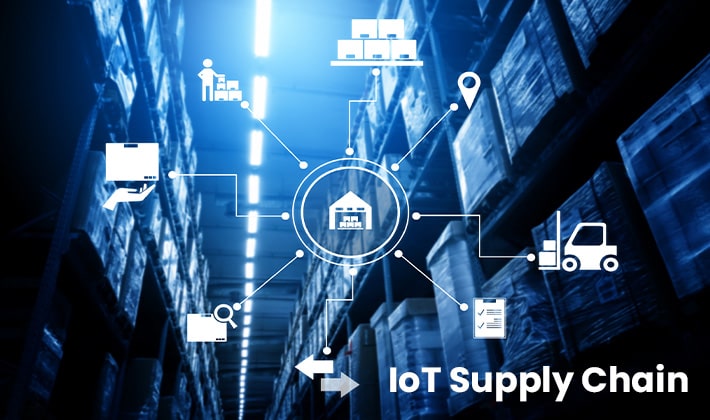
Supply chain management has been transformed by the Internet of Things (IoT), which has emerged as a disruptive technology. IoT provides real-time data gathering, analysis, and automation by linking physical things and devices to the internet, giving supply chain operations unprecedented visibility and control. In this blog, you will learn about the advantages and difficulties of using IoT in the supply chain.
IoT in Supply Chain and Logistics
The Internet of Things (IoT) in logistics is revolutionizing the industry by offering real-time visibility, automation, and data-driven decision-making. IoT devices in the supply chain like sensors and RFID tags enable businesses to monitor shipments in real-time, improving transparency, reducing errors, and optimizing supply chain processes.
Similarly, the impact of IoT on supply chain management is enormous. IoT devices can collect and transmit data about every facet of the supply chain, from inventory levels to transport conditions. This data can be analyzed to identify bottlenecks, forecast demand more accurately, and optimize logistics processes, making supply chain IoT a vital component of modern logistics.
The Internet of Things and Supply Chain: A Symbiotic Relationship
The symbiosis between the Internet of Things and the supply chain is driving efficiencies and enhancements across various supply chain processes. IoT can provide detailed visibility into product life cycles, offering vital insights that can be used to streamline operations and reduce costs. Furthermore, IoT technology can monitor and analyze real-time data from multiple sources across the supply chain, enabling predictive maintenance and proactive risk management.
Harnessing the Power of Logistics IoT
IoT in logistics offers a wealth of opportunities for optimization. Real-time tracking enables logistics providers to monitor shipments constantly, improving delivery accuracy and customer service. IoT sensors can also provide data about storage conditions, vehicle performance, and driver behavior, helping to optimize operations, enhance safety, and reduce costs.
The Role of IoT in Supply Chain Transformation
Supply chain IoT is more than just a trend; it’s a transformative force. IoT technology allows for seamless integration between different supply chain components, creating a more responsive, agile, and customer-centric supply chain. With IoT, businesses can gain real-time visibility into their supply chains, making it easier to identify issues, mitigate risks, and seize opportunities.
- Enhanced Tracking and Visibility
The deployment of IoT sensors and devices along the whole supply chain enables end-to-end visibility and inventory tracking. The risk of theft, spoilage, or damage is decreased thanks to proactive monitoring made possible by real-time data on location, condition, temperature, humidity, and other aspects. By providing organizations with accurate and current information, visibility helps them to make better decisions, manage inventories more effectively, and provide better customer service.
- Inventory management and demand projections
Supply chains powered by IoT provide precise and immediate inventory control. Sensors built into shelves, storage containers, and warehouses continuously track stock levels and send warnings when it needs to be restocked. Businesses may optimize inventory levels, lower stockouts, and avoid overstocking by utilizing IoT data. IoT devices may also gather consumer behavior data to help businesses estimate demand more accurately, which enhances production planning and cuts waste.
- Asset management and predictive maintenance
Predictive maintenance is made possible by IoT sensors incorporated into machinery and equipment, ensuring that assets run as efficiently as possible. IoT devices may anticipate maintenance needs, minimizing downtime and lowering maintenance costs, by gathering data on usage patterns, performance indicators, and future faults. Asset tracking and monitoring improve asset management by giving firms insights into asset utilization rates, location, and condition. This enables them to allocate assets more effectively and reduce loss or theft risks.
- Asset management and predictive maintenance
Predictive maintenance is made possible by IoT sensors incorporated into machinery and equipment, guaranteeing that assets function at their highest level of efficiency. IoT devices can predict maintenance requirements in advance, minimizing downtime and lowering maintenance costs, by collecting data on usage patterns, performance indicators, and probable breakdowns. Asset tracking and monitoring also improve asset management by giving information on usage patterns, locations, and conditions. This information enables businesses to optimize asset allocation and reduce risks of loss or theft.
- Management of the Cold Chain and Quality Assurance
Particularly in sectors like food, pharmaceuticals, and healthcare, the IoT is essential for cold chain management and quality monitoring. IoT sensors keep track of and log temperature, humidity, and other environmental variables while they are being moved or stored. Alerts are sent out once certain criteria are exceeded, allowing for quick remedial action to stop spoilage or damage. This degree of oversight guarantees the quality of the product, legal compliance, and client happiness.
- Protection and risk reduction
IoT technology improves risk management and supply chain security. Businesses can monitor buildings, warehouses, and shipping lanes in real-time, spotting unauthorized entry, theft, or tampering, thanks to IoT-enabled security systems. IoT devices can also track shipments’ geolocations, lowering the chance of theft or loss. Additionally, risk analytics and predictive modeling made possible by the Internet of Things (IoT) assist organizations in identifying potential disruptions like weather disasters or supplier problems, allowing for proactive risk reduction and contingency planning.
Conclusion
The convergence of IoT and supply chain and logistics is reshaping the industry, offering unprecedented levels of visibility, efficiency, and customer satisfaction. Here at nVision Global, we leverage the power of IoT to drive operational excellence and strategic advantage for our clients.
Embracing IoT in supply chain and logistics isn’t just about staying competitive – it’s about becoming a leader in the digital age. Reach out to us at nVision Global today to learn how we can help you harness the power of IoT in your supply chain and logistics operations.